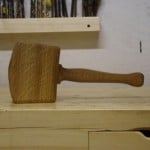Stock preparation
Welcome! / Forums / Project Series / Dining Chair / Stock preparation
Tagged: stock preperation
- This topic has 12 replies, 10 voices, and was last updated 8 years, 7 months ago by
ehisey.
-
AuthorPosts
-
13 September 2015 at 10:37 pm #130383
Hi all,
I just wanted to gauge what everyone does regarding stock preparation for projects like the dining room chair that have a lot of individual, differently sized pieces.
Do people buy a few different thinkesses of stock and cut them all down to size and 4-square each piece?
Or do you get the wood merchants to do the cutting and planing for you?
I always try and do the former, because it is a) cheaper, b) better for my skills. However – it takes me AGES and I am usually impatient to start making the joints! What do other people do? Are the majority of people here staying true to hand tool preparation of their stock? I find it very time consuming….but maybe it’s good for me…
Chris.
-
This topic was modified 8 years, 10 months ago by
Chris Bunney.
-
This topic was modified 8 years, 10 months ago by
Chris Bunney. Reason: text not showing up

I can’t see your text on this page. I cut and pasted from the “activity”.
(Qoute)
Hi all,I just wanted to gauge what everyone does regarding stock preparation for projects like the dining room chair that have a lot of individual, differently sized pieces.
Do people buy a few different thinkesses of stock and cut them all down to size and 4-square each piece?
Or do you get the wood merchants to do the cutting and planing for you?
I always try and do the former, because it is a) cheaper, b) better for my skills. However – it takes me AGES and I am usually impatient to start making the joints! What do other people do? Are the majority of people here staying true to hand tool preparation of their stock? I find it very time consuming….but maybe it’s good for me…
Chris.

I wanted to bump this question as it begs answering, I think.
Anyways, most things I make are from pine, so I’ll get some 2x8s and cut them to size. I have only made one project from hardwood and I bought lumber from a hardwood dealer that was very close in thickness to what I wanted. I then ripped to width and crosscut to length.
Also, I went out and picked up a jointer and thicknesser to go along with my table saw. Preparing stock took up most of my time and I wanted to focus on joinery.
 14 September 2015 at 11:14 am #130420
14 September 2015 at 11:14 am #130420Hi Chris….I consider myself a Hybrid Woodworker. I generally get rough lumber then use power tools to prep the wood.
I used to always reach for a power tool, now my first thought, after prep, is to reach for a hand tool.
 14 September 2015 at 11:17 am #130421
14 September 2015 at 11:17 am #130421I buy rough, cut and plane. Planed wood, particularly planed softwoods, always need re-truing anyway. That said it often takes out a lot of the work.
If I can, I go with the thickness I can get from the board; i.e., if you buy 1″ board and plan to finish at 3/4, but after truing your face side find you can get 7/8 from it, finish at that thickness. Rarely is it vital to hit a particular number. Of course this principle applies just as well to machine planing but has much more pertinence to the hand tool woodworker.
Matt
 14 September 2015 at 3:20 pm #130429
14 September 2015 at 3:20 pm #130429I am in the same boat as you, Chris, and want to know what other people do. I do not have the money or room for power tools, so hand work is my only work. It does take a while, and I always wonder if I am doing something wrong, or expecting too much?
14 September 2015 at 11:24 pm #130443Hi Jotato,
Like you, I don’t have any power tools for stock preparation (the only power tool I have is a very old band saw).
I recently made the sofa table project and prepared all the wood by hand from larger stock. It did take a long time though and I find it a bit tedious!
When I first started out in woodworking, I would often find that in the process of getting a piece of wood 4-square, I would end up making it 1/32 under size in most dimensions due to my inefficiency of getting it square the first time (lots of corrections = loss of material!) Thankfully, I am a bit more skilled at 4-squaring now, but it still happens!
I really want to make the dining room table project too, but I can imagine that preparing the stock for the table top is quite an ordeal!
Out of interest, for those of you who do all the stock preparation by hand, what percentage of a projects time do you think you spend preparing stock? I reckon it is about a 1/4 for me….
Cheers,
C14 September 2015 at 11:25 pm #130444Jude – thanks for reposting my original message.
I have no idea why it did not show up. I tried editing multiple times, but to no avail!
Must have been a bug in the system…
C 15 September 2015 at 12:49 am #130445
15 September 2015 at 12:49 am #130445I buy rough sawn, and try to get stock close to thicknesses I need…I am fortunate to have a small mill nearby that carries a wide selection of North American hardwoods at prices that I am almost embarrassed to repeat, and that can be had in a variety of thicknesses and widths. After that, 100% by hand. I am a carpenter by trade, so use power tools all day long at my job; working with hand tools is immeasurably more rewarding and relaxing, even at the times that it might otherwise qualify as “work”…and the end results are most satisfying indeed.
 15 September 2015 at 2:18 am #130446
15 September 2015 at 2:18 am #130446I try to get thicknesses as close as possible. I’m not so great at hand thicknessing stock if there’s a lot to take off and the scrub plane comes out. Not so good at hand resawing, either. Good way to waste a lot of good wood! I keep at it, practicing hand thicknessing on pine and such that isn’t expensive. One day I’ll get the hang of it.
This is also a reason I’d like to get a bandsaw. Resawing the widely available 8/4 stock boards down to close to what I need would save some $$ and time I’d rather put into other projects.
Other than that, I hand rip and crosscut all my stock.
 16 September 2015 at 1:34 am #130538
16 September 2015 at 1:34 am #130538Until my most recent project, I’ve been using reclaimed wood or purchased 1 x 6 or 2 x 6 pine. With all my larger power tools in storage, I’m doing almost everything by hand. Resawing is a real chore, but I like the exercise. I just hope my hands and shoulders can handle it as I get older. I’d love to have the space for a bandsaw.
My most recent project used rough cut Douglas Fir. Far more expensive than I’m used to, but it was really worth it for some quality wood. The rough dimensions were full sized 2″ x 6″ and 1″ x 6″, so I could get 7/8″ thickness out of the 1″ material. I needed some 1 1/4″ for the legs, so I ripped and resawed the 2″ x 6″ to close dimensions, then planed to final dims.
I roughed out the pieces for a single dining chair at the same time as the pieces for the stool and I probably spent 25% of my time on getting the materials to rough size.
I like what Matt – @chemical_cake – said above. Depending on your project, you may not need to care what the exact final dimensions are. I’m learning that more as I progress. Remember Paul’s “occasional table” project? The four apron pieces were different thicknesses. But by referencing off the outside face of each apron piece, the tenons are all cut appropriately to leave the correct reveal / inset from the legs. And nobody is the wiser unless they get underneath the table with a caliper.
I have a jointer, thickness planner and table saw. The jointer is not tuned properly, so it leaves machine marks. So I will joint lumber by hand, then use the thickness planer. I will use all machines and depending how impatient I am. I figure I have probably anywhere from 3-5 hours of uninterrupted shop time a week, plus 30 mins here and there before or after work. So, I do not want to spend a month preparing lumber. However, if I just need a piece or two, I will use hand tools, because it’s just more convenient. I try not to fuss to much over exact dimensions of the stock, and I’m routinely off by 1/32″ on the thickness, from board to board. I have been using a caliper set at the dimension I want and use it as a gauge to check the 4 corners of the stock. I find that helps me a lot for determining where the discrepancies in thickness are.
When preparing stock by hand, I feel as if I spend as much time preparing the stock as I do on the joinery.. I haven’t timed it, so I don’t know for sure, but it really seems to take forever!! lol Don’t get me wrong, I love the exercise, but I’m glad I am not trying to earn a living off of preparing lumber by hand.
Dan
My answer is a little different. I find after restoring hand tools, that 4 squaring the lumber for use is one of the more satisfying parts of the project. I am starting to “coarse square” my lumber ahead of needs simply because it relaxes me. I am in IT by trade, and getting to spend a few hours in a low tech woodshop heal the soul.
It is so much easier to rip and square a previously 4-sq’d board to size than it is to rip, square and dimension a rough cut board. Also gives me an excuse to practice sharpening and maintaining the tools.
-
This topic was modified 8 years, 10 months ago by
-
AuthorPosts
- You must be logged in to reply to this topic.
